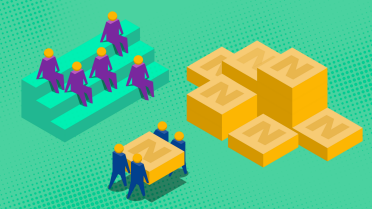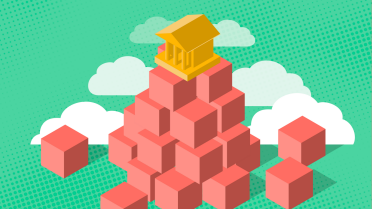It is the end of the dashboard as we know it...
Dashboards have been a great way of providing an overview of one’s financials. But will it be good enough in a few years?



At SEB, we began using hackathons as a method for innovation and learning as early as 2015. Since then, we have successfully hosted seven global hackathons, a dozen innovation days and other themed sessions to dream and explore together.
As an organiser and participant in our hackathons, I have seen firsthand how this method of learning has evolved over the years. It has been challenging - from finding the right balance between freedom and boundaries to managing the high level of enthusiasm and energy that a hackathon can create. But it has also been an enriching journey, where I have seen teams form, ideas grow, and innovation being born.
Participating in hackathons has also contributed to my personal development, by challenging me to think outside the box and collaborate with people I wouldn't have otherwise met. This combination of challenges and benefits makes hackathons an essential tool for promoting innovation and learning within our organisation.
We believe in allowing our employees to explore new ideas and technologies outside their regular backlog. By bringing together people from different departments and disciplines to compete in a time-limited challenge, we have created a culture of collaboration and learning that has given us a competitive edge on the market.
The specific themes for our hackathons have varied quite a bit over the years. Some examples include "Data Quality", "Embedded Finance", "Beyond the Backlog" and "Digital Security". We have also experimented with both open themes and specific focus areas for these events. On one hand, having an open theme allows for more freedom and creativity, as participants are not limited by a specific topic or problem. This can lead to a higher level of energy and engagement, and a wider range of ideas. On the other hand, having a specific focus area can help direct the hackathon’s spotlight, which leads to more targeted and specific solutions - also allowing the opportunity to immerse yourself in a certain topic.
Open themes are my personal preference, as it allows for more energy and attracts more participants. It is, however, worth noting that both have their advantages and disadvantages depending on the goal of the hackathon.
Our last hackathon, the "Golden Hackathon 007", was an open-themed, record-breaking event, with 32 teams and 159 participants spread across different domains, countries and even continents. The theme itself was a reference to this being our seventh hackathon, but also a tribute to a certain fictional secret service agent, who celebrated 60 years in the movie theatres last year.
The event truly showcased the potential and value of collaboration and innovation within our organisation. I was utterly blown away by the quality of the pitches presented by the finalists. Each team had worked hard to develop their ideas and presented them effectively to the panel of judges. It was clear that the participants had put a lot of thought and effort into their presentations - the level of innovation, creativity, and technical skill was truly impressive.
At each hackathon, we have a panel of judges who evaluate the projects based on certain criteria and are responsible for selecting the winner of the Jury Prize. We also have a "People's Vote" category, where participants and other attendees vote for their favourite project. Additionally, our agile coaches give out four other awards to recognise outstanding achievements in different areas such as collaboration, creativity, or technical excellence.
At our last hackathon, the Grand Jury Prize was awarded to team "Moonraker - a Customer Journey" for their prototype which helps improve salespeople's work-life by visualising real-time data.
Team "Sustainability with Every Breath (SEB)" won the People's Vote for their project on creating a gamification experience that promotes a healthy work-life for employees.
One of our agile coaches presented an award for Simplicity to the team "No Time to JCL" for making the complicated simple, by developing and integrating vJCL as an extension to Visual Studio.
The award for Team and Collaboration, presented by another coach, was awarded to the team “Roots cause of Evil”, for their unique approach in giving us an idea of how teams can identify which component is the root cause of an IT incident.
Team "Licence to Detect" was awarded in the Customer Excellence category, for their outstanding technical skills in implementing machine learning to detect and generate alerts of possible fraud patterns.
Saving my personal favourite for last, the winner of the Future To Come prize was awarded to team "Quantum Machine Learning". They managed to prototype and simulate a quantum computer and used machine learning to build a classifier for data.
These awards not only recognise the hard work and achievements of the participants but also serve as an inspiration for others to come up with new and innovative ideas. In addition to this, it also encourages the value of teamwork to achieve a common goal. And even though all ideas don’t end up in a new service or business model, they still echo within the organisation and act as the first of many steps when implementing new and exciting technology. All ideas, teams, prototypes, codes, and outcomes from previous hackathons are archived and stored in a hall of fame, where they can quickly be brought up to life – when the timing and maturity are right.
One of the main challenges that we faced back in 2015, early on in our journey, was the time and effort spent on preparing firewalls and solving hosting for our prototypes. These problems have disappeared over time with the introduction of self-service sandbox services - both in the cloud and local development environments, and containerisation. This saves everyone time since it allows attendees to focus on creating, rather than on setting up infrastructure.
Another challenge we have encountered is the perception that one needs to be a hacker to participate in a hackathon. Contrary to this belief, a hackathon is open to everyone, you do not need to be a developer to participate. It can even be beneficial to have a diverse group of people with different perspectives and skill sets. Within the company, this perception of hackathons has changed over time, as they are no longer seen as something that is solely for developers. Hackathons are for everyone within SEB, regardless of their background, and are part of a cultural journey that we are moving on.
Here are five points that explain why hackathons are fun and engaging, but also a pure form of business agility:
In conclusion, hackathons are a unique and exciting way to foster innovation, cross-collaboration, and learning new skills. Just as important, however, hackathons are also a way of failing fast and being proud of it. Because, as you know, the word “fail” stands for “first attempt in learning”, which is oftentimes better than being static or doing nothing at all. So, if you have yet to attend a hackathon - do it the next time you get the opportunity. Dream big, learn fast, and have fun!
Dashboards have been a great way of providing an overview of one’s financials. But will it be good enough in a few years?

In this article we are writing about SEB Neo, which is a new product that aims to solve the problem of young kids being shut out of the new, cashless society.

Dying bureaucracies or agile key players to count on? The opinions about banks are many. If you ask me, they will continue to play an important role. But to succeed, significant changes are required.

For questions regarding open vacancies or recruiting processes, feel free to send an email to